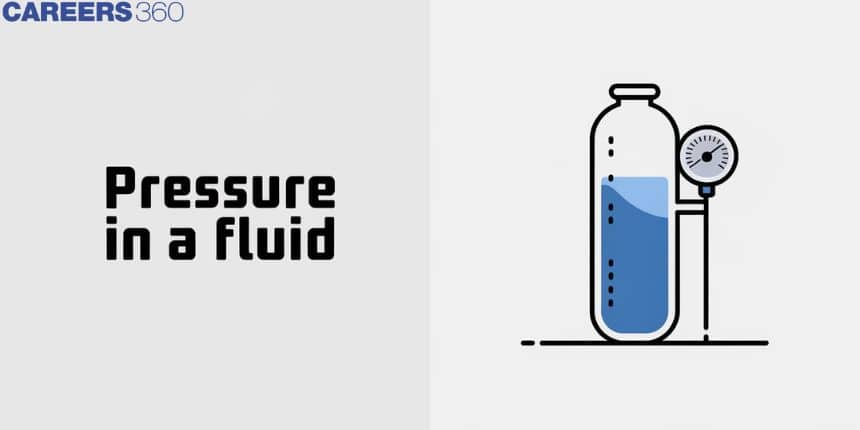Pressure In A Fluid
Pressure in fluids is one of the fundamentals impacting most areas of our lives, often even when one is not aware of it. How water flows smoothly out of your tap, or air pressure that helps in the takeoff of an aircraft from the ground, is really something interesting to learn.
In this article, we will cover the concept of Pressure In A Fluid. This concept falls under the broader category of Properties of Solids and Liquids which is a crucial chapter in Class 11 physics. It is not only essential for board exams but also for competitive exams like the Joint Entrance Examination (JEE Main), National Eligibility Entrance Test (NEET), and other entrance exams such as SRMJEE, BITSAT, WBJEE, BCECE and more.

Pressure In A Fluid
Fluids
Fluids are substances which begin to flow when an external force is applied to it. Fluids examples are liquids and gases. Fluids don't have their own shape but they take the shape of the containing vessel.
In the Hydrostatic branch, we study fluids which are at rest with respect to containing vessels.
While in Hydrodynamics we study fluids which are in motion with respect to containing vessels. For example, the study of flowing water from the tap comes under Hydrodynamics.
Ideal fluids- Assumption
It is Incompressible- This means the density and the specific volume of the fluid do not change during the flow.
It is Non-viscous- Layers of fluids do not exert any tangential force (especially friction force) on each other. And A true "non-viscous" fluid would flow along a solid wall without any slowing down because of friction.
Pressure
Normal force exerted by liquid/fluid at rest per unit Area of the surface is called pressure of a liquid/fluid.
If F is the normal force acting on a surface area A in a container with liquid.
then pressure exerted by the liquid on this surface is P=FA
Units of pressure is N/m2 or Pascal (S.I) and dyne/cm2 (C.G.S)
The dimension of pressure is ML−1T−2
Atmospheric pressure- The pressure exerted by the atmosphere is called atmospheric pressure. 1 atm is the value of atmospheric pressure on the surface of the earth at sea level.
And
1 atm=1.01×105 N/m2=1.01×105Pascal=1.01bar=760torr
So the Relation between Bar and Pascal is 1bar=105 Pa
For More Information On Pressure in a Fluid, Watch The Below Video:
Solved Example Based On Pressure in a Fluid
Example 1: The average depth of the Indian Ocean is about 300m. The fractional compression, ΔVV of water at the bottom of the ocean (given that the bulk modulus of the water = 2.2×109 N/m2 and g=10 m/s2) will be:
1) 0.0532
2) 0.0136
3) 0.044
4) None
Solution:
we know that B=ΔPΔV/V
⇒ΔVV=ΔPB=ρghBΔVV=103×10×30002.2×1.9=0.0136
Hence, the answer is option (2)
Example 2: For the arrangement shown in the figure, what is the density of oil?

1) 416 kg/m3
2) 400 kg/m3
3) 512 kg/m3
4) 916 kg/m3
Solution:
ρ0+ρwgl=ρ0+ρoil (l+d)⋅gρoil =ρωll+d=1000×135(135+12.3)ρoil =916 kg/m3
Hence, the answer is option (4).
Example 3: A metal sphere connected by a string is dipped in a liquid of density $\rho$ as shown in the figure. The pressure at the bottom of the vessel will be: (P = atmospheric pressure)

1) P=P0+ρgh
2) P<P0+ρgh
3) P>P0+ρgh
4) P0
Solution:
Upthrust on the sphere from the liquid makes equal and opposite pairs of forces. Hence, there will be no effect on the pressure at the bottom of the vessel (or)
P=P0+ρghP−P0+ρghh=P−P0ρg
Hence, the answer is option (1).
Example 4: For the arrangement shown in the figure, the force at the bottom of the vessel is-

1) 200 N
2) 100 N
3) 20 N
4) 2 N
Solution:
F=P×AF=(P total )×A=(Pgh)×A=(103×10×1.0)(100×10−4)=100 N
Hence, the answer is option (2).
Example 5: Water is a clean aquarium from a meniscus, as shown in the figure. The difference in height $h$ between the centre and the edge of the meniscus is -

1) 2Tρg
2) Tρg
3) 4Tρg
4) None of them
Solution: